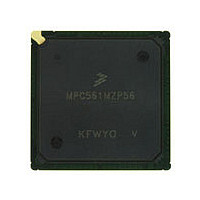MPC561MZP56 Freescale, MPC561MZP56 Datasheet - Page 939

MPC561MZP56
Manufacturer Part Number
MPC561MZP56
Description
Manufacturer
Freescale
Datasheet
1.MPC561MZP56.pdf
(1420 pages)
Specifications of MPC561MZP56
Cpu Family
MPC56x
Device Core
PowerPC
Device Core Size
32b
Frequency (max)
56MHz
Interface Type
QSPI/SCI/SPI/UART
Total Internal Ram Size
32KB
# I/os (max)
56
Number Of Timers - General Purpose
22
Operating Supply Voltage (typ)
2.6/5V
Operating Supply Voltage (max)
2.7/5.25V
Operating Supply Voltage (min)
2.5/4.75V
On-chip Adc
2(32-chx10-bit)
Instruction Set Architecture
RISC
Operating Temp Range
-40C to 125C
Operating Temperature Classification
Automotive
Mounting
Surface Mount
Pin Count
388
Package Type
BGA
Program Memory Type
ROMLess
Program Memory Size
Not Required
Lead Free Status / RoHS Status
Not Compliant
Available stocks
Company
Part Number
Manufacturer
Quantity
Price
Company:
Part Number:
MPC561MZP56
Manufacturer:
Freescale Semiconductor
Quantity:
10 000
Company:
Part Number:
MPC561MZP56R2
Manufacturer:
Freescale Semiconductor
Quantity:
10 000
- Current page: 939 of 1420
- Download datasheet (11Mb)
Entering debug mode is also possible immediately out of reset, thus allowing the debugging of even a
ROM-less system. Using this feature is possible by special programming of the development port during
reset. If the DSCK pin continues to be asserted following SRESET negation (after enabling debug mode)
the processor will take a breakpoint exception and go directly to debug mode instead of fetching the reset
vector. To avoid entering debug mode following reset, the DSCK pin must be negated no later than seven
clock cycles after SRESET negates. In this case, the processor will jump to the reset vector and begin
normal execution. When entering debug mode immediately after reset, bit 31 (development port interrupt)
of the exception cause register (ECR) is set.
When debug mode is disabled all events result in regular interrupt handling.
The internal freeze signal is asserted whenever an enabled event occurs, regardless if debug mode is
enabled or disabled. The internal freeze signal is connected to all relevant internal modules. These modules
can be programmed to stop all operations in response to the assertion of the freeze signal. Refer to
Section 23.5.1, “Freeze
The freeze indication is negated when exiting debug mode. Refer to
Mode.”
The following list contains the events that can cause the CPU to enter debug mode. Each event results in
debug mode entry if debug mode is enabled and the corresponding enable bit is set. The reset values of the
enable bits allow, in most cases, the use of the debug mode features without the need to program the debug
enable register (DER). For more information refer to
(DPDR).”
Freescale Semiconductor
SRESET
DSCK asserts high while SRESET is asserted to enable debug mode operation.
•
•
•
•
CLK
OUT
DSCK
DSCK asserts high following SRESET negation to enable debug mode immediately.
NMI exception as a result of the assertion of the IRQ0_B pin. For more information refer to
Section 3.15.4.1, “System Reset Exception and NMI
Check stop. Refer to
Machine check exception
Implementation specific instruction protection error
Indication.”
0
Section 23.3.1.3, “Check Stop State and Debug
Figure 23-8. Debug Mode Reset Configuration
1
MPC561/MPC563 Reference Manual, Rev. 1.2
2
3
4
5
8
Section 23.6.13, “Development Port Data Register
9
10 11 12
(0x0100).”
Section 23.3.1.6, “Exiting Debug
13 14
Mode,” for more information.
15 16
17
Development Support
23-25
Related parts for MPC561MZP56
Image
Part Number
Description
Manufacturer
Datasheet
Request
R

Part Number:
Description:
MPC5 1K0 5%
Manufacturer:
TE Connectivity
Datasheet:

Part Number:
Description:
MPC5 500R 5%
Manufacturer:
TE Connectivity
Datasheet:

Part Number:
Description:
MPC5 5K0 5%
Manufacturer:
Tyco Electronics
Datasheet:

Part Number:
Description:
MPC5 5R0 5%
Manufacturer:
Tyco Electronics
Datasheet:

Part Number:
Description:
MPC5 50K 5%
Manufacturer:
Tyco Electronics
Datasheet:

Part Number:
Description:
MPC5 1R0 5%
Manufacturer:
Tyco Electronics
Datasheet:

Part Number:
Description:
TOWER ELEVATOR BOARDS HARDWARE
Manufacturer:
Freescale Semiconductor
Datasheet:

Part Number:
Description:
TOWER SERIAL I/O HARDWARE
Manufacturer:
Freescale Semiconductor
Datasheet:

Part Number:
Description:
LCD MODULE FOR TWR SYSTEM
Manufacturer:
Freescale Semiconductor
Datasheet:

Part Number:
Description:
DAUGHTER LCD WVGA I.MX51
Manufacturer:
Freescale Semiconductor
Datasheet:

Part Number:
Description:
TOWER SYSTEM BOARD MPC5125
Manufacturer:
Freescale Semiconductor
Datasheet:












